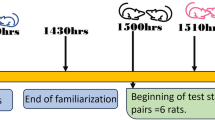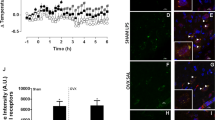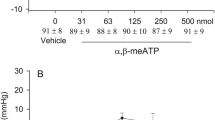Abstract
IT is known that the cardiovascular system is extremely sensitive to the effects of both exogenous1,2 and endogenous3 opiates. In rats, less than 1% of the morphine dose necessary to produce antinociception results in significant hypotension and brady-cardia4. The endogenous opiate β-endorphin is stored along with pituitary adrenocorticotrophin (ACTH)5,6, and the action of stressors seems to result in the release of both peptides5,6. Therefore, it seemed likely that β-endorphin is released during shock states and that it might contribute to the hypotension. To test this hypothesis we used an endotoxin shock model7,8. If endotoxin-induced hypotension were mediated through endorphin release, then blockade of endorphins should reverse such hypotension. Using the specific opiate antagonist, naloxone, we not only rapidly reversed endotoxin-induced hypotension, but also prophylactically blocked its occurrence. These findings suggest that endorphins may have a role in the patho-physiology of shock and that narcotic antagonists should be evaluated for their potential therapeutic value in the treatment of shock.
This is a preview of subscription content, access via your institution
Access options
Subscribe to this journal
Receive 51 print issues and online access
$199.00 per year
only $3.90 per issue
Buy this article
- Purchase on Springer Link
- Instant access to full article PDF
Prices may be subject to local taxes which are calculated during checkout
Similar content being viewed by others
References
Evans, G. J., Nasmyth, P. A. & Stewart, H. C. Br. J. Pharmac. 7, 542–552 (1952).
Gokhale, S. D., Gulati, O. D. & Joshi, N. Y. Br. J. Pharmac. 21, 273–284 (1963).
Florey, J. & Mediavilla, A. Brain Res. 138, 585–590 (1977).
Fennessy, M. R. & Rattray, J. F. Eur. J. Pharmac. 14, 1–8 (1971).
Guillemin, R. et al. Science 197, 1367–1369 (1977).
Rossier, J., French, E. D., Rivier, C., Ling, N., Guillemin, R. & Bloom, F. E. Nature 270, 618–620 (1978).
Waisbren, B. A. Am. J. Med. 36, 819–824 (1964).
Gilbert, R. P. Physiol. Rev. 40, 245–279 (1960).
Chiueh, C. C. & Kopin, I. J. Am. J. Physiol. 234, H-690–695 (1978).
Berkowitz, B. A., Ngai, S. H., Hempstead, J. & Spector, S. J. Pharmac. exp. Ther. 195, 499–504 (1975).
Morrison, D. F. in Multivariate Statistical Methods 133–141 (McGraw-Hill, New York, 1967).
Winer, B. J. in Statistical Principles in Experimental Design 514–539 (McGraw-Hill, NewYork, 1971).
Akil, H., Madden, J., Patrick, R. L. & Barchas, J. D. in Opiates and Endogenous Opioid Peptides (ed. Kosterlitz, H. W.) (North-Holland, New York, 1976).
Walker, J. M. et al. Science 196, 85–87 (1977).
Holaday, J. W., Wei, E., Loh, H. H. & Li, C. H. Proc. natn. Acad. Sci. U.S.A. 75, 2923–2927 (1978).
Moberg, G. P. Am. J. Physiol. 220, 397–400 (1971).
Nies, A. S. in Clinical Pharmacology (eds Melmon, K. L. & Morelli, H. F.) (Macmillan, New York, 1972).
Zweifach, B. W. & Thomas, L. J. exp. Med. 406, 385–401 (1957).
Holaday, J. W., Law, P.-Y., Tseng, L.-F., Loh, H. H. & Li, C. H. Proc. natn. Acad. Sci. U.S.A. 74, 4628–4632 (1977).
Author information
Authors and Affiliations
Rights and permissions
About this article
Cite this article
HOLADAY, J., FADEN, A. Naloxone reversal of endotoxin hypotension suggests role of endorphins in shock. Nature 275, 450–451 (1978). https://doi.org/10.1038/275450a0
Received:
Accepted:
Published:
Issue Date:
DOI: https://doi.org/10.1038/275450a0
This article is cited by
-
Local knee heating increases spinal and supraspinal excitability and enhances plantar flexion and dorsiflexion torque production of the ankle in older adults
European Journal of Applied Physiology (2020)
-
Biomedical Vignette
Journal of Biomedical Science (2005)
-
Effects of naltrexone on lipopolysaccharide-induced sepsis in rats
Journal of Biomedical Science (2005)
-
An Assessment of Possible Protective Roles of Morphine and Naloxone on the Acute Toxicity of T-2 Toxin
Cereal Research Communications (1997)
Comments
By submitting a comment you agree to abide by our Terms and Community Guidelines. If you find something abusive or that does not comply with our terms or guidelines please flag it as inappropriate.



